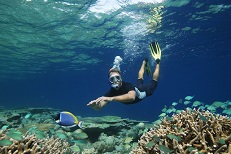 BANGKOK—For over 15 years the team at Anantara Hotels, Resorts & Spas has been committed to protecting the local environment, communities and culture around each of its hotels and resorts while creating authentic, luxury travel experiences and indigenous adventures for modern travelers. With four luxury resorts in the Maldives—Anantara Kihavah Villas, Anantara Dhigu Resort, Anantara Veli Resort and Naladhu Maldives—guests can take their pick from some of the best locations and experiences in the Indian Ocean, including getting up close and personal with the local marine life and vibrant coral reefs, snorkeling with manta rays in a UNESCO World Biosphere Reserve, free diving with whale sharks or cruising the house reef 18 meters below the surface, just a few strokes out from the shoreline.
BANGKOK—For over 15 years the team at Anantara Hotels, Resorts & Spas has been committed to protecting the local environment, communities and culture around each of its hotels and resorts while creating authentic, luxury travel experiences and indigenous adventures for modern travelers. With four luxury resorts in the Maldives—Anantara Kihavah Villas, Anantara Dhigu Resort, Anantara Veli Resort and Naladhu Maldives—guests can take their pick from some of the best locations and experiences in the Indian Ocean, including getting up close and personal with the local marine life and vibrant coral reefs, snorkeling with manta rays in a UNESCO World Biosphere Reserve, free diving with whale sharks or cruising the house reef 18 meters below the surface, just a few strokes out from the shoreline.
In line with the luxury hospitality brand’s philosophy that environmental responsibility begins at home, the Anantara team in the Maldives joined forces with marine biologists from Coral Reef CPR—conservationists, biologists and ecologists whose mission is to reduce threats and promote sustainable management and rehabilitation of reef ecosystems—in October 2015 to develop ways to protect the coral ahead of the anticipated environmental stresses of El Niño, a climate cycle that has a global impact on weather patterns.
Led by Chief Scientist, Dr. Andrew Bruckner, the pioneering five-year program, Holistic Approach to Reef Protection or ‘HARP’, encompasses practical environmental protection and marine education with the goal of limiting potential damage to the reefs in the Maldives and ensuring the coral reefs continue to not only survive, but to thrive. As well as Anantara taking its responsibility to the local environment very seriously, the program will also ensure that guests at each resort—as well as the local community—can continue to enjoy the spectacular world beneath the waterline for many years to come.
Corals in the Maldives
Extending across the expansive Laccadive Sea in the Indian Ocean, the Maldives is a country of atolls; small coral islands encircled by azure lagoons. Unique to the Maldives, luxury resorts are the sole occupants of each island, providing a truly private and unique experience. Coral reefs beneath the shimmering waters of the Maldives protect the pristine beaches and guard the crystal-clear lagoons. They also support an astounding array of tropical fish, crustaceans and bizarre-looking molluscs. But for all of its beauty and apparent resilience, coral is a sensitive organism, vulnerable to extreme weather, sudden environmental changes, the effects of global climate change, as well as outbreaks of coral predators.
Principal investigator and lead scientist with Coral Reef CPR, Dr. Andrew Bruckner, explains, “Some reefs in the Maldives are experiencing unusually high water temperatures which is causing coral bleaching. These coral animals contain symbiotic single-celled algae within their tissues, which provide the coral with up to 90 percent of its energy. Once stressed, the coral expels these algae, causing them to turn completely white. If algae loss is prolonged and the stress continues, corals can die. But it’s not all doom and gloom, when a coral turns white, it is not dead and if the stress-caused bleaching is not severe, coral can recover.”
Director of Conservation for Minor Hotels, John Roberts, elaborates further, “On their first visit in October 2015 the visiting marine biologists performed a major Crown of Thorns Starfish removal from the reefs surrounding Anantara resorts in South Male Atoll. In the process, the scientists helped save a great reef on Anantara Veli Resort, which is now also proving most resilient to current bleaching. As part of those efforts last year, Coral Reef CPR and Anantara have produced a manual to distribute throughout the country outlining best practice should there be another Crown of Thorns Starfish outbreak.”
A Holistic Approach to Reef Protection (HARP)
In collaborating with leading experts in their fields for groundbreaking marine biology research, Anantara is pioneering the HARP program. Currently all project work undertaken in the Maldives by Coral Reef CPR for HARP is funded by the Anantara initiative “Dollars For Deeds”, whereby Anantara guests are invited to donate one dollar for each night of their stay, which is then matched dollar for dollar by Minor Hotels. Dollars for Deeds funds raised in the Maldives are committed over the coming five years to three key focus areas: protection of marine and coastal environments; environmental education; and community welfare.
In January this year, Coral Reef CPR returned to the Maldives for the first of four monitoring phases throughout 2016. Ten monitoring stations were set up on coral reefs surrounding Anantara resorts in South Male Atoll and Baa Atoll, with the purpose of evaluating the water conditions and marine populations before, during and post 2016 El Niño phenomena. Already widely reported by international media across the globe as being the longest El Niño on record, during Coral Reef CPR’s second visit to the Maldives in April this year, promising results have been extracted from the monitoring stations, despite some alarming findings.
“Since the beginning of March, temperatures on the reef have exceeded 30°C and they remained above 31°C during April, reaching 32 to 33 °C in lagoonal environments,” explains Dr. Andrew Bruckner. “Under normal conditions, sea water temperatures should be three to four degrees cooler at depth but these high temperatures are extending beyond 35 meters depth. These high water temperatures are due to an unprecedented El Niño event which is now in its second year. Simultaneously the sea has been unusually calm which has allowed excessive levels of UV light radiation to penetrate the reefs.”
“Due to stressful conditions corals in some areas in the Maldives began to pale in color at the beginning of April and several sensitive species bleached white,” Bruckner added. “By mid-April between 60 and 80 percent of corals on the reef we were monitoring were fully bleached or a very light yellow in color. In certain shallow lagoonal environments bleaching was much more severe, and sensitive corals were affected. On a positive note, by the end of April temperatures on Baa Atoll had begun to decline and there was very little coral mortality on the outer reefs.”
Super Corals
Through this research some surprising and exciting revelations have been discovered. Georgia Coward, Project Manager and Fishery Biologist with Coral Reef CPR said, “Although the level of bleaching is similar to that reported during previous El Niño events and is comparable to reports from other countries, we have observed a number of colonies of each species that have proven resistant to changing conditions, possibly by producing protective fluorescent pigments. Similarly certain colonies have not bleached at all despite being located adjacent to corals of the same species that bleached severely. We refer to these as “super corals” and feel that these may have adapted to elevated sea temperatures. Over the coming months we will be analyzing extracts taken from the super corals and other coral species in laboratory conditions, as well as looking closely at the fish population reports surrounding them.”
Sustainability
In line with Anantara’s commitment to sustainability and a result of the luxury hospitality brand’s ongoing conservation efforts including the HARP project, Anantara Kihavah Villas, Anantara Dhigu Resort, Anantara Veli Resort and Naladhu have all been awarded with Green Growth Certification, an assessment framework for the travel and tourism industry which consists of 37 criteria and 406 indicators. It is based on global standards and international conventions including the UN Global Compact and the UNEP Green Economy Principles.
Future Visits
Since 2011, guests staying at Anantara resorts in South Male Atoll and Baa Atoll have been able to leave a lasting legacy by participating in coral reef propagation programs and contribute to the ongoing conservation effort by adopting a coral frame and planting it with the guidance of Anantara’s resident marine biologists. The HARP program now builds on those initial efforts, with a high level scientific-based practical approach to reef assessment, regeneration and community science.
The third and fourth phases of the HARP Program with Anantara involve creating a coral nursery to assist in the rehabilitation of degraded and damaged reefs. Through coral mariculture, when the scientists return in July and October 2016, small branches from the identified super corals will be extracted and propagated. Once matured, these corals will be transplanted back on to the reef.
During the visits from Coral Reef CPR scientists, guests at the Anantara resorts in both South Male Atoll and Baa Atoll can enhance their diving and snorkeling experiences by joining the marine biologists on their excursions, and participate in Anantara’s endeavors to keep the reefs healthy and vibrant for generations to enjoy.
Future visits from Dr. Andrew Bruckner, Georgia Coward and other Coral Reef CPR scientists are set for the end of July until mid-August 2016 and October 2016.
Go to Anantara.






